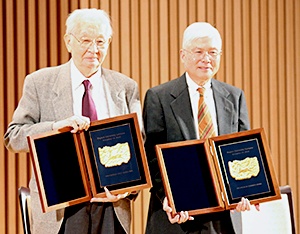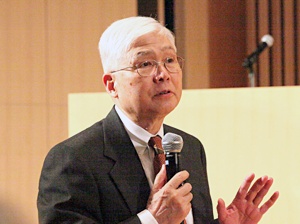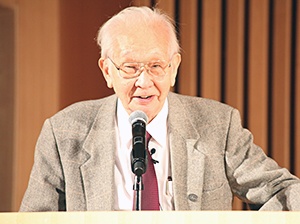Features
Features
Seeing the light
- ツイート
- 2010/12/30
The 2010 Autumn Nagoya University Lecture held on 13 November 2010 shone a light on the world of naturally occurring pharmaceutical molecules and provided a dazzling display of world-class synthetic organic chemistry.
The Nagoya University Lecture, known colloquially as the Meidai Lecture, is one of the highlights of the academic year at Nagoya University and is an opportunity for the institution to showcase its connections to world-class researchers from around the globe whose careers have had strong links to the university. Recent recipients of the lecture award have included Nobel laureates Sir Harold Kroto, Osamu Shimomura, Toshihide Maskawa, Makoto Kobayashi and carbon nanotube pioneer Sumio Iijima. The May 2010 lecture honored geneticist Masahiro Sugiura and structural biologist Masatoshi Takeichi1.
As well as providing an opportunity for Nagoya University to celebrate the contribution it has made to international science, the Meidai Lecture is a key activity in its program of scientific outreach to the local community, presenting top-flight research to non-specialists and the lay public. As with previous lectures in the series, a significant proportion of the audience came from the local community and included many junior high and high school students.
 The 2010 Autumn Nagoya University Lecture, once again held in the Toyoda Auditorium at the heart of the university campus, was entitled 'Using chemistry to unravel the secrets of life: From natural molecules to drugs' and honored two outstanding figures of the world of synthetic organic chemistry: Professor Yoshito Kishi of Harvard University and Colombia University's Centennial Professor Emeritus, Koji Nakanishi.
The 2010 Autumn Nagoya University Lecture, once again held in the Toyoda Auditorium at the heart of the university campus, was entitled 'Using chemistry to unravel the secrets of life: From natural molecules to drugs' and honored two outstanding figures of the world of synthetic organic chemistry: Professor Yoshito Kishi of Harvard University and Colombia University's Centennial Professor Emeritus, Koji Nakanishi.
The natural world is the source of an unimaginable variety of complex molecules, some of which are highly beneficial or even essential for human life while others are lethally toxic in the minutest quantities. The science of constructing these naturally occurring compounds step-by-step from scratch in the laboratory is known as natural product 'total synthesis', and depending on the complexity of the target this process can involve a route comprised of many tens or even hundreds of chemical steps that often take teams researchers many years to devise. Both Kishi and Nakanishi are world leaders in the science of total synthesis and have a combined total of over a century of experience in the field.
The careers of Nakanishi and Kishi are intimately connected to Nagoya University and have followed remarkably similar paths. Both obtained their undergraduate degrees from the university, in 1947 and 1961 respectively, and subsequently their PhDs, in 1954 and 1966, both under the tutelage of Yoshimasa Hirata, one of the founding figures of post-war Japanese natural products chemistry. Nakanishi and Kishi also share a connection with Harvard University, where Nakanishi carried out postgraduate research with pioneering synthetic organic chemist Louis Feiser prior to studying for his doctoral degree, and where Kishi spent time as a postdoctoral researcher in the group of legendary synthetic organic chemist and 1965 Nobel Laureate Robert B. Woodward. Although both Nakanishi and Kishi subsequently returned to academic positions at Nagoya University at different times, both have spent a large part of their careers in the US. Nakanishi is currently Emeritus Professor at Columbia University, and Kishi is back at Harvard University where he holds the post of Morris Loeb Professor of Chemistry, Emeritus.

The first of the 2010 lectures was given by Kishi on the topic of 'Complex natural products: structure and synthesis'. Drawing on his years of experience, Kishi gave a guided tour of the joys and trials of synthesizing some of the most complex molecules ever tackled by chemists, including the puffer fish toxin tetrodoxin, the anti-cancer marine natural product halichondrin B -- the latter isolated from the sea sponge Halichondria okadai by his mentor Yoshimasa Hirata -- and the marine natural product palytoxin, the largest and most complex non-peptide molecule ever synthesized by chemists in the laboratory.
One of the key points in Kishi's lecture was the role played by chirality in natural product synthesis. Chirality is the property by which molecules can exist in two three-dimensional 'stereochemical' or mirror-image forms, often likened to our left and right hands. Such pairs of mirror-image molecules, known as enantiomers, frequently have radically different biological properties despite having the same composition. The vast majority of natural products exist exclusively in only one enantiomeric form, and when making them in the laboratory it is vital to synthesize only the molecule with the correct 'handedness'. Structurally complex chiral molecules such as those synthesized by Kishi can have a large number of points of chirality within them, leading to huge numbers of possible stereochemical permutations; over 1021 stereoisomers are possible for palytoxin for example (a total of 1,180,591,620,717,411,303,424 possible stereoisomeric forms).

Before a molecule can be synthesized, however, its structure must be established. In the second Meidai Lecture on 'A life spent in the discovery and structural elucidation of new natural products', Nakanishi spoke about his sixty-year career in which he has clarified the structures of over 200 complex naturally occurring molecules, including the active ingredient in ginko leaves (ginkolide B), ponesterone A and brevetoxin B -- the latter being a causative agent of neurotoxic shellfish poisoning. To meet these formidable challenges, Nakanishi has pioneered the development and use of new analytical methods that are now employed routinely by researchers around the world. Nakanishi was the first to apply the technique known as nuclear Overhauser effect nuclear magnetic resonance spectroscopy, which provides information about which atoms in a molecular are next to each other and so allows the structure of complex molecules to be determined. He also developed exiton-coupled circular dichroism, a method that uses polarized light to distinguish between enantiomers of chiral molecules. Both have revolutionized the way organic synthesis is carried out.
Not only has Nakanishi changed the way chemists look at synthesis, he has also changed the way we see the world or at least our understanding of how we see it. In recent years his studies on retinal analogues -- a class of molecules that detect light in the eye -- have made a major contribution to our understanding of the molecular basis for vision, and related work has shed light on possible causes for age-related macular degeneration.
As is customary, during the event both lecturers were presented with handsome Nagoya University Lecture commemorative plaques embossed with the kirin, a mythical Chinese beast symbolizing wisdom. It is clear that once again the Meidai Lecture awards could not have gone to more worthy recipients.
NU Research
(English)

